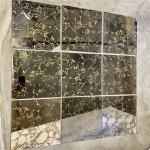Does a Samsung TV Have Screen Mirroring?
Samsung TVs are renowned for their smart functionalities, offering users a range of features beyond traditional television viewing. One commonly sought-after feature is screen mirroring, the ability to wirelessly display the content of a smartphone, tablet, or computer screen directly onto the television. This article explores the screen mirroring capabilities of Samsung TVs, addressing common queries and providing practical guidance.
Understanding Screen Mirroring on Samsung TVs
Most Samsung Smart TVs manufactured after 2012 support screen mirroring, utilizing various technologies depending on the specific model and operating system. Older models may employ technologies like Miracast, while newer models often leverage proprietary Samsung protocols or integrated support for standards like Apple AirPlay 2. Understanding the specific technology employed by a particular Samsung TV model is crucial for successful screen mirroring.
Samsung's Smart View app, available on both Android and iOS devices, often serves as the primary tool for establishing a screen mirroring connection. This app facilitates the discovery of compatible devices and the initiation of the mirroring process. Alternatively, some Samsung TVs offer direct integration with specific platforms, such as Apple AirPlay 2, allowing users to mirror content directly from compatible Apple devices without the need for intermediary apps.
It is important to distinguish screen mirroring from simple screencasting or media sharing. Screen mirroring replicates the entire device's screen, including all actions and displayed content. Screencasting, on the other hand, typically involves sharing specific media files or streaming content from a particular application to the television.
Identifying Screen Mirroring Compatibility
Determining whether a particular Samsung TV supports screen mirroring requires identifying the model number and consulting the television's user manual or Samsung's official support website. The model number is usually located on a sticker on the back of the television. Once located, this information can be used to search the Samsung website for the TV's specifications, including supported wireless display technologies.
Alternatively, navigating the TV's on-screen menu can often reveal the presence of screen mirroring functionality. Look for options labelled "Screen Mirroring," "Smart View," "Wireless Display," or similar terms within the network or input settings menus. The specific naming conventions may vary depending on the TV's model and operating system.
Verifying the compatibility of the source device (smartphone, tablet, or computer) is equally important. Devices must support the same wireless display protocols as the television to ensure seamless mirroring. For instance, a device employing Miracast will not be able to directly mirror to a television supporting only AirPlay 2.
Establishing a Screen Mirroring Connection
The process of establishing a screen mirroring connection varies depending on the specific technologies involved. For Samsung Smart View, the process typically involves launching the app on the source device, ensuring both the TV and the source device are connected to the same Wi-Fi network, and then selecting the desired Samsung TV from the list of available devices displayed within the app. The TV may prompt for confirmation before the mirroring session begins.
For TVs with AirPlay 2 support, mirroring from an Apple device is usually simpler. Users can open the Control Center on their Apple device, tap the "Screen Mirroring" icon, and select the Samsung TV from the list of available AirPlay devices. No dedicated app is required for this process.
Troubleshooting connection issues often involves verifying the network connection, ensuring both devices are on the same Wi-Fi network and that the network is functioning correctly. Restarting both the TV and the source device can also resolve minor connectivity problems. Consulting the user manuals for both devices can provide further troubleshooting steps for specific models.
Beyond these methods, some devices may offer additional connectivity options, such as using a wired connection through an HDMI cable for screen mirroring. While this approach does not offer the same wireless convenience, it can provide a more stable and reliable connection in environments with congested or unreliable Wi-Fi networks.
Utilizing Screen Mirroring Features
Screen mirroring allows users to enjoy a variety of content on a larger screen. Sharing photos and videos with family and friends, presenting slideshows or documents for meetings, or simply enjoying mobile games on a larger display are just a few examples of the diverse applications of this technology.
Certain limitations and considerations apply when using screen mirroring. Latency, the delay between actions performed on the source device and their appearance on the TV screen, can be a factor, particularly with resource-intensive applications or games. Network congestion can also impact the quality and stability of the mirrored display.
Understanding the specific features and limitations of the chosen mirroring technology is essential for a smooth and productive screen mirroring experience. Consulting the user manuals for both the TV and the source device can provide valuable insights into optimizing performance and troubleshooting potential issues.

How To Mirror From Your Samsung Smartphone Tv

Screen Mirroring To Your Samsung Tv

How To Use Screen Mirroring Function Of Smart Tv Samsung New Zealand

What Is Screen Mirroring And How Do I Use It With My Samsung Tv Mobile Device

How To Screen Mirroring Iphone Samsung Tv

Screen Mirroring On The Tv With Galaxy S5 Samsung Malaysia

A Guide To Screen Mirroring From Android Samsung Lg Sony And Roku Tvs Dignited

Screen Mirror To Samsung Tv Android Mac Ios Free App

Detailed Guide On How To Mirror Samsung Phone Tv

Smart Tv Screen Mirroring Multi View Samsung Singapore








